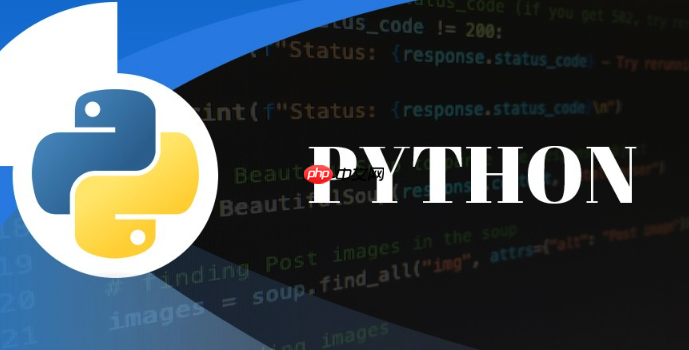推荐先检查路径是否存在,因为os.path.isfile()和os.path.isdir()在路径不存在时均返回False,无法区分“非文件/目录”与“路径不存在”的情况,易导致逻辑错误;通过先调用os.path.exists()可明确路径是否存在,再结合isfile()或isdir()精准判断类型,提升代码健壮性与语义清晰度。

在Python中,要判断一个给定的路径是文件还是目录,我们主要依赖标准库中的
os.path
os.path.isfile()
os.path.isdir()
要判断一个路径是文件还是目录,最直接的方法是使用
os.path
首先,你需要导入
os
import os
然后,你可以使用以下两个函数:
立即学习“Python免费学习笔记(深入)”;
os.path.isfile(path)
path
True
False
os.path.isdir(path)
path
True
False
一个常见的实践是,在调用
isfile()
isdir()
os.path.exists(path)
示例代码:
import os
# 假设我们有一些路径
file_path = "my_document.txt" # 假设这是一个文件
dir_path = "my_folder" # 假设这是一个目录
non_existent_path = "non_existent_thing"
# 创建一些测试文件和目录
# 注意:在真实环境中,这些文件和目录可能已经存在
# 这里是为了演示而创建
if not os.path.exists(file_path):
with open(file_path, 'w') as f:
f.write("This is a test file.")
if not os.path.exists(dir_path):
os.makedirs(dir_path)
print(f"路径 '{file_path}':")
if os.path.exists(file_path):
print(f" 存在: True")
print(f" 是文件: {os.path.isfile(file_path)}")
print(f" 是目录: {os.path.isdir(file_path)}")
else:
print(f" 存在: False")
print(f"\n路径 '{dir_path}':")
if os.path.exists(dir_path):
print(f" 存在: True")
print(f" 是文件: {os.path.isfile(dir_path)}")
print(f" 是目录: {os.path.isdir(dir_path)}")
else:
print(f" 存在: False")
print(f"\n路径 '{non_existent_path}':")
if os.path.exists(non_existent_path):
print(f" 存在: True")
print(f" 是文件: {os.path.isfile(non_existent_path)}")
print(f" 是目录: {os.path.isdir(non_existent_path)}")
else:
print(f" 存在: False")
# 清理测试文件和目录(可选)
# os.remove(file_path)
# os.rmdir(dir_path)通过这种方式,你可以非常清晰地判断任何给定路径的类型。
在我看来,这是一个非常关键的编程习惯,尤其是在处理文件系统操作时。很多时候,我们调用
os.path.isfile()
os.path.isdir()
False
False
比如,你可能想说:“如果它是个文件,就读取它;如果是个目录,就遍历它;否则,就告诉我它不存在。”但如果你不先检查
os.path.exists()
isfile()
isdir()
False
举个例子,如果
my_path
"non_existent_file.txt"
if os.path.isfile(my_path):
print("这是一个文件")
elif os.path.isdir(my_path):
print("这是一个目录")
else:
print("既不是文件也不是目录") # 这句话可能会让人误解这段代码对于不存在的路径,会输出“既不是文件也不是目录”。但更准确的表述应该是“路径不存在”。通过先检查
os.path.exists()
if os.path.exists(my_path):
if os.path.isfile(my_path):
print(f"'{my_path}' 是一个文件。")
elif os.path.isdir(my_path):
print(f"'{my_path}' 是一个目录。")
else:
# 理论上,如果exists()为True,但isfile()和isdir()都为False,
# 那么它可能是一个符号链接(未被跟随),或者其他特殊文件系统对象
print(f"'{my_path}' 存在,但既不是常规文件也不是目录 (可能是符号链接或特殊设备)。")
else:
print(f"'{my_path}' 不存在。")这样的结构,无疑能让你的代码更健壮,逻辑更清晰。
os.path
符号链接(Symbolic Link,也叫软链接)在文件系统中是个有趣的存在,它就像一个快捷方式,指向另一个文件或目录。在Python的
os.path
默认情况下,
os.path.isfile()
os.path.isdir()
os.path.isfile()
True
os.path.isdir()
True
但如果你想知道一个路径本身是不是一个符号链接,而不是它指向什么,那就需要用到
os.path.islink()
还有一点值得注意,就是
os.path.exists()
os.path.lexists()
os.path.exists(path)
path
path
exists()
False
os.path.lexists(path)
path
path
lexists()
True
示例:
import os
# 假设我们有一个文件
target_file = "original_file.txt"
with open(target_file, 'w') as f:
f.write("This is the original content.")
# 创建一个指向该文件的符号链接
symlink_to_file = "link_to_file.txt"
os.symlink(target_file, symlink_to_file)
# 创建一个指向不存在目标的符号链接(断开的链接)
broken_symlink = "broken_link.txt"
if os.path.exists("non_existent_target"): # 确保目标不存在
os.remove("non_existent_target")
os.symlink("non_existent_target", broken_symlink)
print(f"处理 '{symlink_to_file}' (指向文件的符号链接):")
print(f" os.path.islink(): {os.path.islink(symlink_to_file)}") # True,因为它本身是链接
print(f" os.path.isfile(): {os.path.isfile(symlink_to_file)}") # True,因为它指向一个文件
print(f" os.path.isdir(): {os.path.isdir(symlink_to_file)}") # False
print(f" os.path.exists(): {os.path.exists(symlink_to_file)}") # True,因为目标存在
print(f" os.path.lexists(): {os.path.lexists(symlink_to_file)}") # True,因为链接本身存在
print(f"\n处理 '{broken_symlink}' (断开的符号链接):")
print(f" os.path.islink(): {os.path.islink(broken_symlink)}") # True
print(f" os.path.isfile(): {os.path.isfile(broken_symlink)}") # False (目标不存在,所以不是文件)
print(f" os.path.isdir(): {os.path.isdir(broken_symlink)}") # False (目标不存在,所以不是目录)
print(f" os.path.exists(): {os.path.exists(broken_symlink)}") # False (目标不存在)
print(f" os.path.lexists(): {os.path.lexists(broken_symlink)}") # True (链接本身存在)
# 清理
os.remove(target_file)
os.remove(symlink_to_file)
os.remove(broken_symlink)理解这些细微之处,能让你在编写处理文件系统的脚本时更加精确和安全,尤其是在自动化任务或文件管理工具中。
os.path
当然有!Python从3.4版本开始引入了
pathlib
pathlib
os.path
pathlib
path
path
核心思想:
Path()
is_file()
is_dir()
exists()
pathlib
os.path
pathlib
path_obj.exists()
path_obj.is_file()
path_obj.is_dir()
path_obj.is_symlink()
示例代码:
from pathlib import Path
import os # 仍然可能需要os模块进行文件创建/清理
# 假设我们有一些路径
file_path_str = "my_pathlib_document.txt"
dir_path_str = "my_pathlib_folder"
non_existent_path_str = "non_existent_pathlib_thing"
# 创建一些测试文件和目录
if not os.path.exists(file_path_str):
with open(file_path_str, 'w') as f:
f.write("This is a test file for pathlib.")
if not os.path.exists(dir_path_str):
os.makedirs(dir_path_str)
# 将字符串路径转换为Path对象
file_path = Path(file_path_str)
dir_path = Path(dir_path_str)
non_existent_path = Path(non_existent_path_str)
print(f"路径 '{file_path}':")
if file_path.exists():
print(f" 存在: True")
print(f" 是文件: {file_path.is_file()}")
print(f" 是目录: {file_path.is_dir()}")
else:
print(f" 存在: False")
print(f"\n路径 '{dir_path}':")
if dir_path.exists():
print(f" 存在: True")
print(f" 是文件: {dir_path.is_file()}")
print(f" 是目录: {dir_path.is_dir()}")
else:
print(f" 存在: False")
print(f"\n路径 '{non_existent_path}':")
if non_existent_path.exists():
print(f" 存在: True")
print(f" 是文件: {non_existent_path.is_file()}")
print(f" 是目录: {non_existent_path.is_dir()}")
else:
print(f" 存在: False")
# 清理(使用Path对象来清理也更方便)
file_path.unlink(missing_ok=True) # 删除文件,如果不存在也不报错
dir_path.rmdir() # 删除空目录对于符号链接,
pathlib
os.path
is_file()
is_dir()
is_symlink()
from pathlib import Path
import os
# 创建一个目标文件
target_file_pl = Path("target_for_pathlib.txt")
target_file_pl.write_text("Hello from pathlib target!")
# 创建一个符号链接
symlink_pl = Path("link_from_pathlib.txt")
if not symlink_pl.exists(): # 避免重复创建
os.symlink(target_file_pl, symlink_pl)
print(f"\n使用 pathlib 处理 '{symlink_pl}' (指向文件的符号链接):")
print(f" symlink_pl.is_symlink(): {symlink_pl.is_symlink()}") # True
print(f" symlink_pl.is_file(): {symlink_pl.is_file()}") # True (跟随链接)
print(f" symlink_pl.is_dir(): {symlink_pl.is_dir()}") # False
print(f" symlink_pl.exists(): {symlink_pl.exists()}") # True (目标存在)
# 清理
target_file_pl.unlink(missing_ok=True)
symlink_pl.unlink(missing_ok=True)总的来说,
pathlib
以上就是python中怎么判断一个路径是文件还是目录?的详细内容,更多请关注php中文网其它相关文章!

python怎么学习?python怎么入门?python在哪学?python怎么学才快?不用担心,这里为大家提供了python速学教程(入门到精通),有需要的小伙伴保存下载就能学习啦!

Copyright 2014-2025 https://www.php.cn/ All Rights Reserved | php.cn | 湘ICP备2023035733号